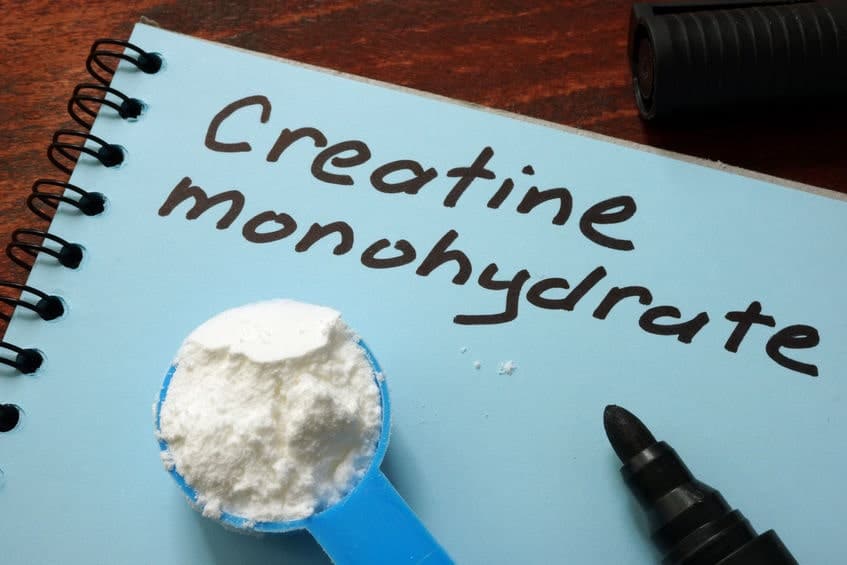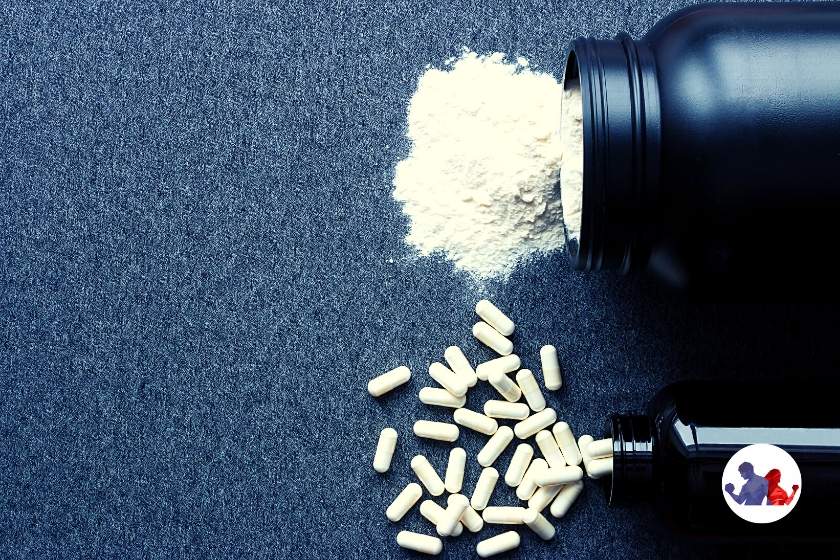Creatine is one of the most popular supplements in the world. Research on the supplement has found it to improve muscle strength, muscle mass, and athletic performance.
While the impact the substance has is clear, there are often questions about how to best take creatine.
Some believe that for creatine supplementation to be most effective, something known as “creatine loading” must occur.
This article will discuss creatine loading and determine whether it is an essential requirement for creatine supplementation.
Table of Contents
What Is Creatine?
Creatine is a substance that is required for energy replenishment and regeneration. Although small amounts are stored in other tissues, the majority of creatine is stored in muscle cells.
Creatine impacts another compound known as adenosine triphosphate or ATP. ATP is the energy-giving substance that the body requires to power a number of processes.
When ATP is used up by the body, creatine acts to recycle ATP and supply the body with energy (1).
The ability that creatine has to increase the amount of energy has made creatine a highly popular training supplement.
By increasing creatine intake and energy available, the muscles are capable of performing high-power contractions for a longer time period.
What Is Creatine Loading?
Creatine loading refers to taking high doses of creatine for the first week or two of supplementation.
There is great potential for creatine storage within the muscles. One study on creatine suggests that, with a standard diet that includes meat and fish, stores are only 60–80% full (2).
Therefore, the purpose of creatine loading is to rapidly increase and maximize the amount of creatine stored within the muscles.
After a period of loading, the creatine stores will reach an optimal level. At this point, the dosage can be reduced to maintain high amounts of creatine in the muscle.
Studies on creatine loading have indicated that the approach can substantially enhance creatine stores by as much as 40% (3).
Creatine Loading Phases
There are two phases of creatine supplementation:
- The loading phase
- The maintenance phase
The creatine loading phase typically lasts for seven to fourteen days of creatine supplementation. The length of time required is dependent on the dosage used.
Once this phase has been completed, creatine does not need to be loaded again unless supplementation is ceased.
After the loading phase, we transition to the maintenance phase which involves taking creatine at a lower dosage. This phase lasts an indefinite amount of time.
The muscles are saturated with creatine at this stage and, therefore, the lower dosage ensures high levels of creatine are maintained.
Is Creatine Loading Necessary?
While creatine loading is recommended, it is not an essential requirement. It is possible to supplement creatine without the use of a creatine loading period.
Using low doses of creatine consistently will still increase the amount of creatine stored within the body.
A study assessing low-dosage creatine supplementation found that intramuscular creatine levels peaked after twenty-eight days of supplementation (4).
Therefore, it is possible to reap the benefits of creatine without a loading phase. However, it may take longer for these benefits to be experienced.
Benefits Of The Creatine Loading

Utilizing creatine loading and maximizing creatine storage quickly can have a significant effect on physical performance.
This section will highlight four benefits of creatine loading.
1. Enhanced Muscle Size
What the Science Says
There are a number of factors that influence the rate of muscle growth. However, for muscle growth to occur, strength training must be performed regularly.
Strength training applies mechanical tension, metabolic stress, and damage to the muscles (5). As a result, the muscles are repaired and increase in size.
By loading creatine, the body is able to generate larger quantities of energy and improve exercise performance.
This greater training intensity increases muscle tension, stress, and damage, therefore, enhancing the potential for muscle hypertrophy.
A meta-analysis looking at the effectiveness of specific supplements recommended creatine for increasing muscle size (6).
2. Increased Muscle Strength
What the Science Says
As mentioned, creatine loading can lead to rapid improvement in exercise performance. This can positively impact muscle strength as well as muscle hypertrophy.
One study investigated the impact of creatine on strength levels and weightlifting performance.
The results clearly indicated that taking creatine led to a significant increase in both strength and performance (7).
This strength improvement is attributed to the impact creatine has on ATP. Studies suggest that it takes approximately ten seconds for ATP to be used up during high-intensity exercise.
However, by taking creatine, the time taken for ATP to deplete is extended thus boosting strength capabilities.
3. Greater Athletic Performance
What the Science Says
Creatine has long been associated with improving explosive movements such as jumping and sprinting.
It is theorized that by increasing the amount of creatine stored in the muscles, the muscles can contract more powerfully.
A number of studies that recommend creatine supplementation for improving athletic performance. As a result, creatine is commonly taken by athletes of many sports.
One six-week study determined that creatine supplementation significantly improved vertical jump performance, power output, work capacity (8).
Results from a second study investigating creatine and sprinting performance confirmed that the substance enhanced 40-meter sprint times (9).
4. Prevention of Injury
What the Science Says
Some individuals believe that creatine can negatively impact hydration and lead to an increased risk of muscle cramping.
However, research suggests that creatine users experience fewer episodes of cramping and dehydration (10).
However, the results of this study go further than just hydration and cramping.
Researchers determined that muscle tightness, strains, pulls, and non-contact injuries occurred less often in creatine users.
Furthermore, there are studies that suggest creatine may also play a role in rehabilitation. It may reduce muscle damage and minimize the amount of muscle strength and size lost (11).
Best Creatine Supplements
Our team have picked up the best creatine supplements currently on the market to support your goals.Is It Safe?

Over the years, there have been a number of concerns raised over the supplementation of creatine.
Creatine is one of the most thoroughly studied substances in science and research suggests that creatine is safe for both short and long-term consumption.
The substance has a low toxicity profile and appears to cause few side effects providing that recommended dosages are adhered to (12).
One study assessing creatine safety determined that consuming 30 grams per day may be safe for as long as five years.
One of the main concerns associated with creatine supplements is the impact it has on kidney function.
Taking creatine may increase the production of a substance known as creatinine. High levels of this substance have been associated with causing kidney impairment.
However, long-term studies on the impact of creatine supplements on kidney function have found no detrimental impact (13).
That said, creatine may not be suitable for those with kidney issues. Therefore, speak to a doctor if unsure.
Creatine may also not be appropriate for those who are pregnant or breastfeeding.
It is crucial to speak to a doctor before taking any creatine supplement.
How Do You Load Creatine?
There are a number of suggested ways to load creatine. Some use higher dosages and a shorter loading phase while others prefer lower doses with a longer loading phase.
The International Society of Sports Nutrition recommends taking a total of 20 grams of creatine per day. The 20 grams should be broken down into four separate five-gram doses (14).
By following this recommendation, the loading phase should last between five to seven days.
We then move into the maintenance phase where creatine levels are significantly reduced. Taking three to five grams per day will ensure that high creatine levels are maintained.
It is possible to use different loading schemes, however, for the most optimal results, follow these guidelines.
Are There Side Effects?
For most individuals, creatine is safe to consume and does not cause serious side effects.
That said, some reports have associated creatine with gastrointestinal problems such as diarrhea, nausea, and vomiting. However, these seem rare.
Increasing creatine levels within the body appear to increase water retention. Therefore, although not severe, weight gain and bloating may also be experienced.
Due to water retention, some believe that creatine supplementation can cause dehydration and muscle cramps.
The evidence does not support this belief. As highlighted earlier, a number of studies have determined that creatine may prevent dehydration and muscle cramps (15).
The Bottom Line
For those who are looking to maximize muscle size, strength, and performance, creatine loading is recommended.
Creatine loading is the process of taking large doses of creatine for a short period of time. The purpose of this is to rapidly increase the amount of creatine stored in the muscles.
While creatine loading is not compulsory, it will optimize the rate of change.
Creatine has been thoroughly researched over the years and has consistently been found to improve muscle size, strength, and performance.
Although some individuals have concerns over creatine consumption, studies have shown creatine to be safe for consumption.
However, those who have kidney problems must consult a doctor prior to taking creatine supplements.
Best Creatine Supplements
Our team have picked up the best creatine supplements currently on the market to support your goals.- https://www.ncbi.nlm.nih.gov/pmc/articles/PMC3963244/
- https://www.ncbi.nlm.nih.gov/pubmed/21346331
- https://jissn.biomedcentral.com/articles/10.1186/s12970-017-0173-z
- https://pubmed.ncbi.nlm.nih.gov/8828669/
- https://www.ncbi.nlm.nih.gov/pubmed/20847704
- https://www.ncbi.nlm.nih.gov/pubmed/12433852
- https://www.ncbi.nlm.nih.gov/pubmed/14636102
- https://journals.lww.com/nsca-jscr/abstract/1999/05000/the_effects_of_6_weeks_of_creatine_monohydrate.9.aspx
- https://www.ncbi.nlm.nih.gov/pubmed/9809381
- https://www.ncbi.nlm.nih.gov/pubmed/12701814
- https://www.ncbi.nlm.nih.gov/pmc/articles/PMC3407788/#__sec8title
- https://pubmed.ncbi.nlm.nih.gov/28615996/
- https://www.ncbi.nlm.nih.gov/pubmed/31375416
- https://www.ncbi.nlm.nih.gov/pmc/articles/PMC2048496/
- https://www.ncbi.nlm.nih.gov/pmc/articles/PMC233174/
